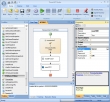Quicksearch
Friday, June 19. 2009
Demo Video of DinamiQs Virtual Storm
Full software management through Active Directory enables you to keep track on licenses, saving tremendous amounts of money, every day again.
• Scale from 1 to 100,000 clients
• Out Perform end user expectations
• Reduce Entire IT Environment Requirements to absolute minimum
• Secure your data- beyond military grade security
• Save on all levels-hardware, licenses, bandwidth, power, administration, support, maintenance
• Simplify installation, management and applications
• Attain 98+% Application Compatibility and Interoperability
• Improve your bottom line, ROI in 6 months or less, then see real savings
• Experience the scalability, performance and cost savings only available through DinamiQs
Here’s the a Dutch spoken video showing Virtual Storm in action managing desktops hosted on vSphere 4. The demo is presented by Mike Jansen. Continue reading "Demo Video of DinamiQs Virtual Storm" »
Thursday, June 18. 2009
Dutch VMUG Event @ Sun Microsystems
This evening I attended a Dutch VMUG meeting hosted by Sun Microsystems in Amersfoort. As usual I was able to collect some video footage. The speakers at this mini event were Viktor van den Berg, Jaap Romers, Sander van der Post and Mike Jansen. They delivered a good show.
I had the opportunity to see a great demo of the Sun Ray Connector for VMware View Manager. It connects users of Sun Ray clients to Windows virtual machines via the VMware View Manager. It provides a Sun Ray kiosk session that allows users to connect to their virtual machines. The kiosk session prompts the user for their Active Directory user name and password. Then the user is shown a list of available desktops, or is logged directly into their desktop, if there is only one available. The user does not have to enter their password again at the Windows login.
Wednesday, June 17. 2009
PowerWF Studio for VMware
 I downloaded a copy of this workflow package and did some tests with it, these guys are awsome.
I downloaded a copy of this workflow package and did some tests with it, these guys are awsome.
PowerWF Studio for VMware is a suite of tools for automating and administering virtual machine operations and the guests within virtual machines. Leveraging the VMware's VIX API plus several other PowerWF activities packs, PowerWF Studio for VMware offers levels of automation typically only seen in enterprise class solutions. The product supports management of VMware Server, Workstation, Player, and Virtual Infrastructure (both ESX and vCenter).
The VIX activity pack furnishes building blocks that allow you to quickly develop complex workflows that automate virtual machine operations, as well as the guests within virtual machines. PowerWF supports all the functions available within VMware's VIX API with none of complexities. PowerWF protects your existing investments by giving you myriad ways to use your workflows, including within shell scripts, an existing .NET application, or integrated with PowerShell.
Tuesday, June 16. 2009
The official VMware vSphere training guides have arrived!
I just received the official VMware vSphere: Install, Configure, Manage [V4] training guides. If you're upgrading from VMware Infrastructure 3, VMware vSphere: What's New covers new features and how to perform the upgrade. If VMware vSphere is your first virtualization experience, VMware vSphere: Install, Configure, Manage covers all the skills you need to get started.
Objectives
• Install and configure ESX
• Install and configure vCenter Server
• Configure and manage ESX networking and storage using vCenter Server
• Deploy and manage virtual machines
• Manage user access to the VMware infrastructure
• Increase scalability using vCenter Server
• Monitor resource usage using vCenter Server  • Apply patches using VMware vCenter Update Manager
• Apply patches using VMware vCenter Update Manager
• Manage higher availability and data protection using vCenter Server
If you living in the Netherlands, you might want to attend one of the first VMware vSphere: Install, Configure, Manage courses and Join me at the vSphere ICM training in Nieuwegein.
Friday, June 12. 2009
The free StorMagic SvSAN can leverage 2 Terabytes
There is a lot going on in the server virtualization market these days. HP announced the new virtualization bundles that incorporate a Storage Virtual Appliance from LeftHand (acquired by HP). At VMWorld last fall, VMware started to promote the concept of Storage Virtual Appliances and presentations on vSphere 4.0 include Storage Virtual Appliances as an area of interest for VMware.
Why is there so much noise about it?
First of all, you need shared storage in order to take full advantage of the enhanced features of VMware. VMotion isn’t compelling if you’re able to move the application, but the datastore becomes unavailable. HP has already demonstrated that by incorporating a Storage Virtual Appliance they can offer bundles at prices that are attractive for SMB and branch office customers while providing access to VMotion and DRS at the same time.
Why is this important?
SMB customers and branch offices have had to go without the high availability and ease of management features they get with VMotion and DRS, because of the cost of the external shared storage. With a Storage Virtual Appliance, the cost of the shared storage is a fraction of the cost of a traditional SAN or NAS.
What’s still missing?
It’s still too complicated. Most of the virtual appliances have tried addressed the issue of leveraging the server’s resources, but haven’t addressed the complexity issue. Many are using them as a means to either demonstrate core functionality or to move customers into an external SAN.
Dry Run “Managing VMware vSphere 4 with The Virtualization EcoShell”
At the end of the VMware Fast-track course I delivered this week, I did a Dry Run “Managing VMware vSphere 4 with The Virtualization EcoShell” which I will present next week at the Belgium User Group event. If you didn’t sign up yet and you’re interested in this free event you can register here. Maybe we can meet up and enjoy one of those Palm beers. All the content will be delivered in English.
Tuesday, June 9. 2009
vWire goes live
 According to Stephen Beaver, co-author of two books on virtualization, "Essential VMware ESX Server" and "Scripting VMware Power Tools: Automating Virtual Infrastructure Administration", Tripwire Virtualization Evangelist, “virtualization is unique in that there can be thousands of unique configuration properties in a virtual infrastructure, and the number quickly goes up when you consider multiple objects. For example, a moderately small installation with two clusters, six ESX hosts, and 60 VMs will have 38,700 configuration properties for the clusters, hosts, and VMs. vWire’s configuration automation gives virtual administrators new visibility to effectively monitor and manage configuration, change and performance data across the virtual infrastructure – all from within VMware vCenter™ Server.”
According to Stephen Beaver, co-author of two books on virtualization, "Essential VMware ESX Server" and "Scripting VMware Power Tools: Automating Virtual Infrastructure Administration", Tripwire Virtualization Evangelist, “virtualization is unique in that there can be thousands of unique configuration properties in a virtual infrastructure, and the number quickly goes up when you consider multiple objects. For example, a moderately small installation with two clusters, six ESX hosts, and 60 VMs will have 38,700 configuration properties for the clusters, hosts, and VMs. vWire’s configuration automation gives virtual administrators new visibility to effectively monitor and manage configuration, change and performance data across the virtual infrastructure – all from within VMware vCenter™ Server.”
Sunday, June 7. 2009
Xtravirt Global Virtualization Capacity Assessment Service
On Monday, June 8th Xtravirt will launch a global capacity planning service. This service will combine the knowledge/expertise from Xtravirt and the technology from Lanamark to make it easier for enterprises world-wide to get started with desktop and server virtualization.
 “Capacity planning is an essential component for any organisation wishing to adopt virtualisation; whether it be desktop replacement or a server consolidation exercise,” states Paul Davey, CTO of Xtravirt. “We have kept the whole process as simple as possible,” continues Paul. “Collected data, consisting of performance metrics, are securely uploaded to the Xtravirt VReady Portal, where they are analyzed to produce a summary VReady Assessment Report. This can be subsequently extended and we can quickly produce a comprehensive analysis, including full what-if scenarios, solution optimization and licensing calculations. If a client wishes to use a particular brand of server, or server SKU, they can let us know and we can feed it into the design.”
“Capacity planning is an essential component for any organisation wishing to adopt virtualisation; whether it be desktop replacement or a server consolidation exercise,” states Paul Davey, CTO of Xtravirt. “We have kept the whole process as simple as possible,” continues Paul. “Collected data, consisting of performance metrics, are securely uploaded to the Xtravirt VReady Portal, where they are analyzed to produce a summary VReady Assessment Report. This can be subsequently extended and we can quickly produce a comprehensive analysis, including full what-if scenarios, solution optimization and licensing calculations. If a client wishes to use a particular brand of server, or server SKU, they can let us know and we can feed it into the design.”
Saturday, June 6. 2009
The newest edition of Trilead VM Explorer even has support for ESX 4i
 Trilead VM Explorer is a management tool that eases management, backup and disaster recovery tasks in your VMware ESX Server environment. You get maximum flexibility: backups can be stored to ESX, Windows, Linux and FreeBSD based storage platforms or directly to a SAN. Their newest edition even has support for the ESX 3i & ESX 4i server.
Continue reading "The newest edition of Trilead VM Explorer even..." »
Trilead VM Explorer is a management tool that eases management, backup and disaster recovery tasks in your VMware ESX Server environment. You get maximum flexibility: backups can be stored to ESX, Windows, Linux and FreeBSD based storage platforms or directly to a SAN. Their newest edition even has support for the ESX 3i & ESX 4i server.
Continue reading "The newest edition of Trilead VM Explorer even..." »
Kodiak 0.0.4 has been released!
Kodiak version 0.0.4 release notes:
This version contains the following bug fixes:
SSL/TLS issues when connecting to VirtualCenter servers and using the SSL bypass.
This issue was composed of 3 separate cases: * Servers with self-signed certificates caused Kodiak to terminate the connection. Fixed. * Servers with an CommonName mismatch caused Kodiak to terminate the connection. Fixed. * Servers that would demand a client certficiate would terminate the connection when the TLS/SSL handshake was incomplete (i.e. lacking a certificate).
These 3 issues have been fixed, and their respective overrides may be accessed by using the SSL preferences panel.
Kodiak exits on hitting the "Q" key on linux when attempting to login. The "Cmd+q/Alt+Q" rapid menu handler has been temporarily removed while we troubleshoot this. When connected to more than one server, Kodiak's maps overlap and become cluttered/difficult to manage. This has been fixed...Maps will now automatically move themselves to make space for new connections.
Just tested, anyone else gets an Error #2032?





